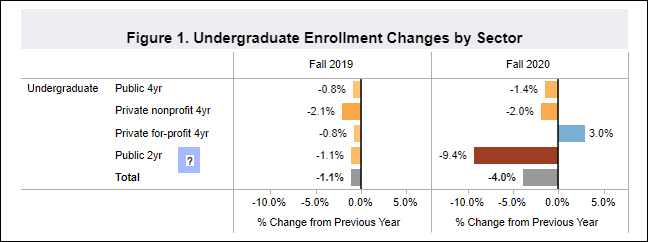Community colleges have seen an alarming 9.4% drop in enrollment this fall compared to fall 2019, according to a new report from the National Student Clearinghouse Research Center.
“Community colleges’ enrollment decline is now nearly nine times their pre-pandemic loss rate (-1.1% for fall 2019 compared to fall 2018),” the NSC Center states. “Even more concerning, the number of freshmen also dropped most drastically at community colleges (-22.7%).”
The latest statistics are even more negative than a report issued by the Clearinghouse in September.
Two-year institutions saw the biggest enrollment declines among all types of institutions of higher education. Overall, fall 2020 undergraduate enrollment is down 4% compared to the same time last year.
Enrollment has declined 1.4% at public four-year colleges and 2.0% at private nonprofit four-year colleges. For-profit four-year colleges are running 3% higher than last fall. Also, enrollment is up 16.8% at primarily online undergraduate institutions.
A lost generation
Many anticipated increased enrollment at community colleges due to the economic downturn and because students were expected to transfer from universities, said NSC Center Executive Director Doug Shapiro at a briefing on the report. In that context, “the decline at community colleges is even more worrisome.”
Shapiro noted that record unemployment in the previous four years before the pandemic resulted in enrollment declines at community colleges ranging from 1.5% to 3%.
The report doesn’t analyze why enrollment dropped so much, but Shapiro speculated that community college students face more challenges than other higher education students with online learning and access to computers and the internet. In addition, he said, community colleges have more vocational and hands-on programs that are more difficult to quickly transition to an online format.
If community colleges can switch to more in-person instruction, Shapiro said, “it will probably help them, but it’s hard to say.”
“Community college students are probably struggling much more with family finances and affordability, as well as online learning,” he said. “Those students are probably less likely to come back six months or even a year from now. There’s a real risk that this entire generation of students will take many, many years to recover.”

“Community colleges are realizing declining enrollments across the country,” said Walter G. Bumphus, president and CEO of the American Association of Community Colleges. “The numbers equate to more than 600,000 students who are not enrolled in community colleges and indicate that community colleges will be needed more than ever to provide a pathway to education and relevant job training.”
“We are hearing from several sources that community college students are looking for in-person learning,” Bumphus said. “The change to remote learning was absolutely necessary but the enrollment figures show us that it is not a good long-term solution for many students.”
“Because of the decline in enrollment, as well as the economic impact of the pandemic, community colleges are potentially facing steep cuts to their funding allocations at a time when they need more support than ever,” he said. “More importantly, hundreds of thousands of students are not getting the education they need to advance to higher-level degrees and jobs.”
Fewer first-time students
“Community colleges are down steeply across the board,” Shapiro said. Enrollments dropped 9.5% to 10% at rural and urban campus and 8.2% at suburban campuses.
Associate degree enrollments declined 8.7% this fall compared to fall 2019. That follows a 2.4% drop last year.
The number of students seeking certificates fell 8.9% in fall 2020 from last fall. That follows a 2.3 percent decline in fall 2019.
“Most strikingly, freshman students are by far the biggest decline of any group from last year, with a decrease of 16.1% nationally and a 22.7% drop at community colleges in particular,” the NSC Center reports. “First-time students account for 69% of the total drop in undergraduate enrollment.”
When broken down by age, first-time student enrollment at public two-year colleges this fall declined 19.1% for 18- to 20-year olds, 26.0% for ages 21-24, 23.1 percent for ages 25-29, and 30.1 percent for ages 30 and up.
Shapiro called the big drop in community college freshmen “a big surprise” and “pretty staggering,” noting that in 2019, first-time enrollment was up at public community colleges while declining at other institutions.
A deeper dive
At public two-year colleges, enrollment of part-time students declined 10.1% and full-time enrollment declined 8.2% compared to the same period last year.
Among all types of higher education institutions, American Indian and Native Alaskan students suffered the sharpest decline of all racial/ethnic undergraduate students, with a 10.7% decline.
Enrollment overall dropped 7.9% for Black students, 7.6% for white students, 6.1% for Hispanic students, and 4.0% for Asian students. International student enrollment declined 13.7%.
Those numbers were surprising, Shapiro said. “We expected to see steeper declines among Black, Latinx and Native American students due to the impact of the labor market and pandemic, which is affecting those communities the most.”
Male undergraduate enrollment fell by three times the rate of female enrollment, at 6.4% versus 2.2%. That’s true at almost all types of institutions, and “that’s a bit of a mystery to us,” Shapiro said.
The report is based on data from 9.2 million students, or nearly 54% of postsecondary institutions, as of Sept. 24. The next enrollment update is scheduled to be released Nov. 12. The NSC Center will release its first study of the impact of COVID on transfer behavior on Oct. 29.

